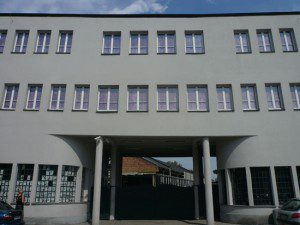
I met a couple of teachers this week. At least, I came to know a little of their stories. There’s not much I can relate. They were both Polish. One was named Ciechanowski Jan, born in March 1882. And Brem Jerzy was born in September 1914, as the Great War began. They both came to the area of Poland, around Krakow, in 1941. Or, more correctly, they were brought there, to the small town of Oswiecim, which German armies then occupied. Only the Nazis renamed the place Auschwitz. And here’s the way their records summed up those two teachers:
“Jan, number 11193, executed Oct. 29, 1941” and “Jerzy, number 10190, executed August 19, 1942.”
I led a Canadian tour group to Krakow this week and brought them to Auschwitz-Birkenau concentration camp to meet teachers Jerzy and Jan and several hundred thousand other victims of that reign of terror during the Second World War. On Tuesday afternoon, we all passed through the gate with the infamous slogan posted above: “Arbeit Macht Frei” or “Work will make you free.”
And then we entered one of the darkest places on earth, where Hitler’s henchmen herded, imprisoned, starved, tortured and then murdered countless thousands simply because of their ethnic origins, their racial background, their sexual preference, or, in the case of Jerzy and Jan, for being purveyors of knowledge that the Nazis decided had to be exterminated.

I found the photographs of teachers Jerzy and Jan hanging on a brick wall inside one of the blockhouses of Auschwitz prison. In the photos, their heads and faces are shaved clean. They both wear the striped prison shirts and numbered tattoos on their arms, forced on them by the Nazis. The process was designed to deprive them of everything, including their identities.
And yet, in their eyes, I saw a flicker of personality and a last morsel of humanity – perhaps the only thing their captors could not take away from them. Perhaps because he was younger, I saw in

Mr. Jerzy a look of defiance, and in Mr. Jan, perhaps because he had more years, a look of knowing, as if, in spite of what he sensed was about to happen to him, there might be hope of a future better than his present. But it was all snuffed out in a torture chamber, a solitary cell, an executioner’s order and finally the ashes of a crematory oven there at Auschwitz.
On the same day, I led my travel group to 4 Lipowa St., near the former Jewish ghetto in Krakow. It’s the address of a wartime enamelware manufacturer named Schindler. Yes, he was the man made famous by the Steven Spielberg, Academy-Award-winning movie “Schindler’s List.”
It was here, that card-carrying Nazi, Oskar Schindler employed no fewer than 1,200 Jewish workers and saved them from the fate assigned teachers Jerzy and Jan. Here is where one man, in U.S. Secretary of State Hillary Clinton’s words, could not “stand by in quiet revulsion, hoping the world will fix itself.” Schindler insisted on hiring the condemned.
“He employed me at this factory although he knew I would be useless to him,” one of those on Schindler’s list later reported.

And inside the former pots and pans factory in Krakow, we not only found stories of those saved by a businessman with a conscience. We also learned how and why it was that my two teacher acquaintances were such a threat to Herr Hitler and his regime. Among the exhibits inside Schindler’s factory/museum, is the account of an interesting arrest. On Nov. 6, 1939, professors at the Jagiellonian University in Krakow faced the wrath of Nazi occupation. An SS officer described their crime:
“Your university has always been the source of malice and hostility toward the Third Reich,” he said. “We are going to take you to a POW camp and inform you of the real situation.”
The Nazis’ real situation was the capital punishment that professors Jerzy and Jan faced in 1942. Of 183 instructors arrested that November day at Jagiellonian University, perhaps half were interrogated, tortured and executed as criminals, when all they were guilty of was teaching the humanities, sciences, the arts and history to their college classes.
Late Tuesday morning, my tour group completed its tour of Schindler’s factory on Lipowa Street. Adorning the outside of the original factory windows are the photographs of those men and women whom Schindler put on his list and saved. They survived via his risky generosity.
The rest – including the 1.2 million Jewish civilians imprisoned and murdered at Auschwitz-Birkenau concentration camp – did not have a Schindler to save them. One wonders whether anyone would stand up for the equivalent of wartime teachers Jerzy and Jan, in Syria or Burma or during a humanitarian crisis in one of our First Nations communities.